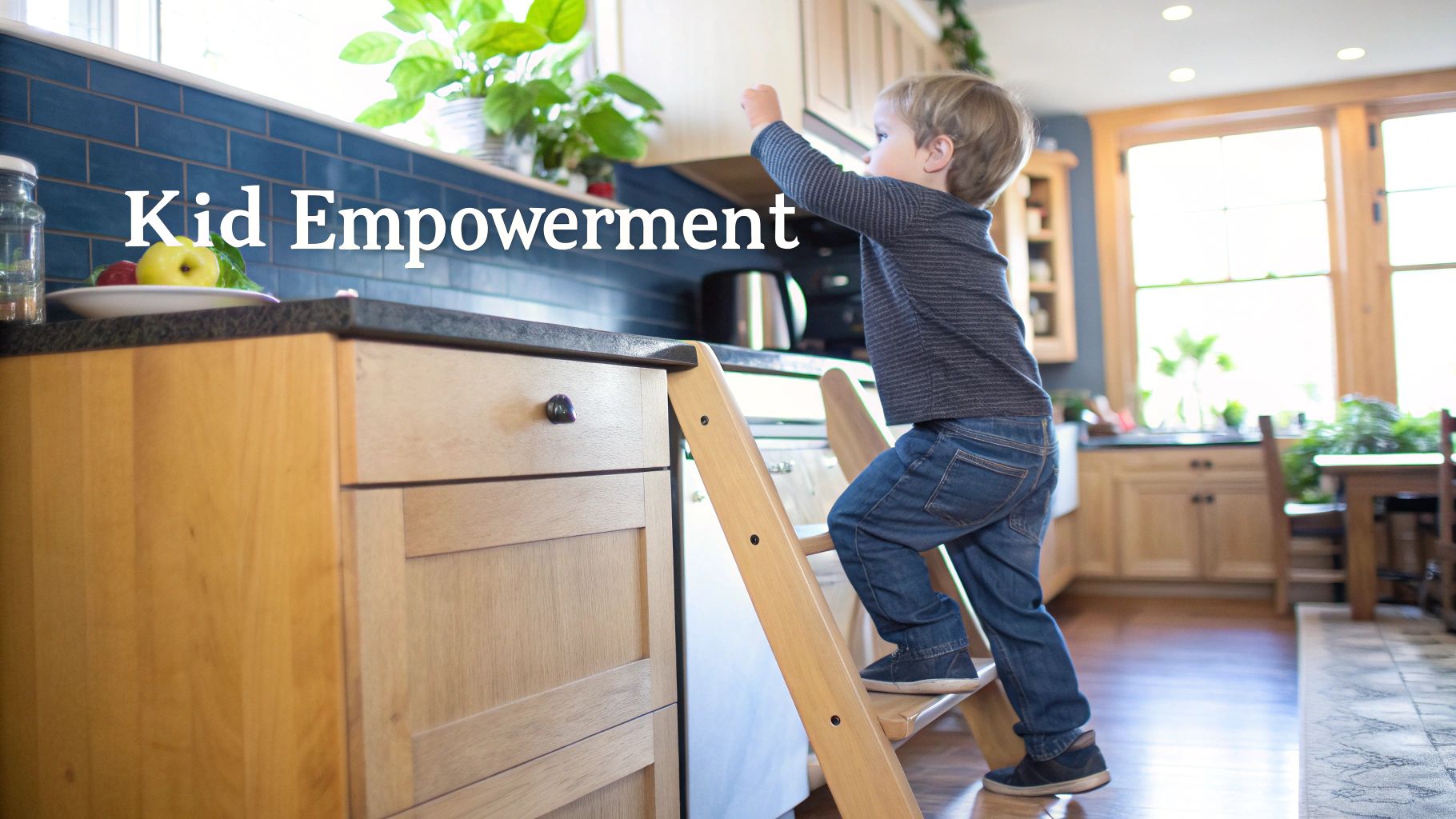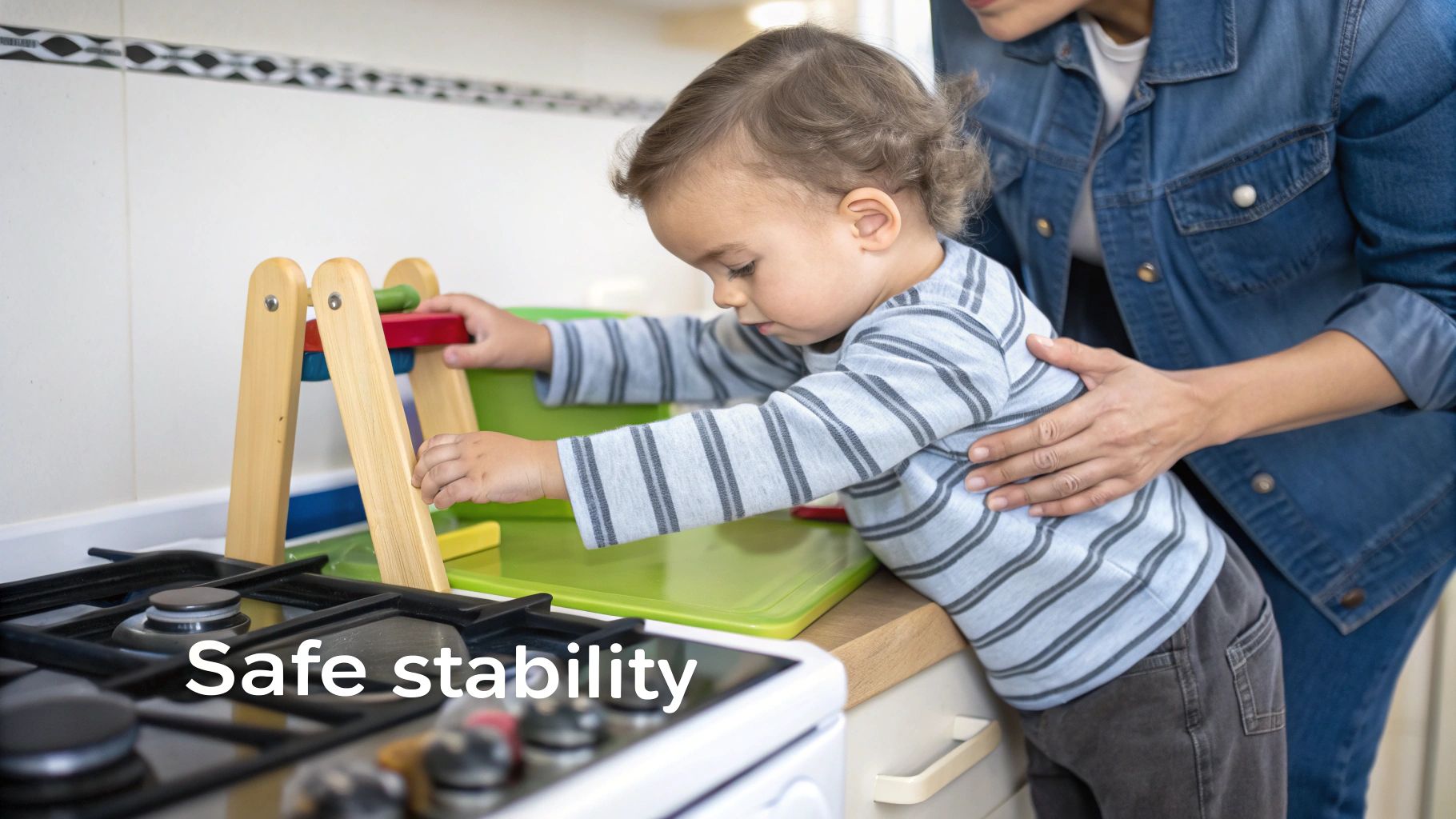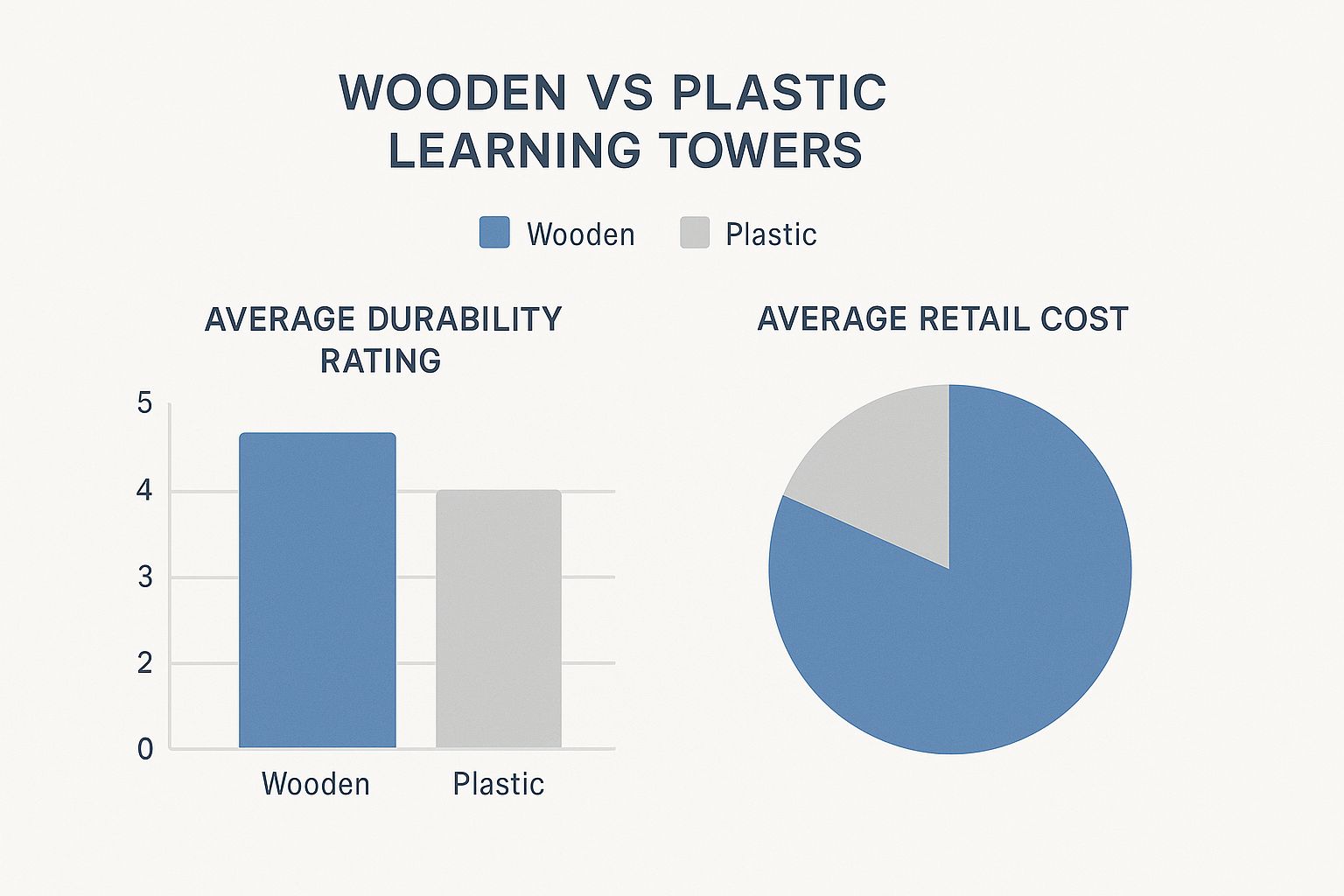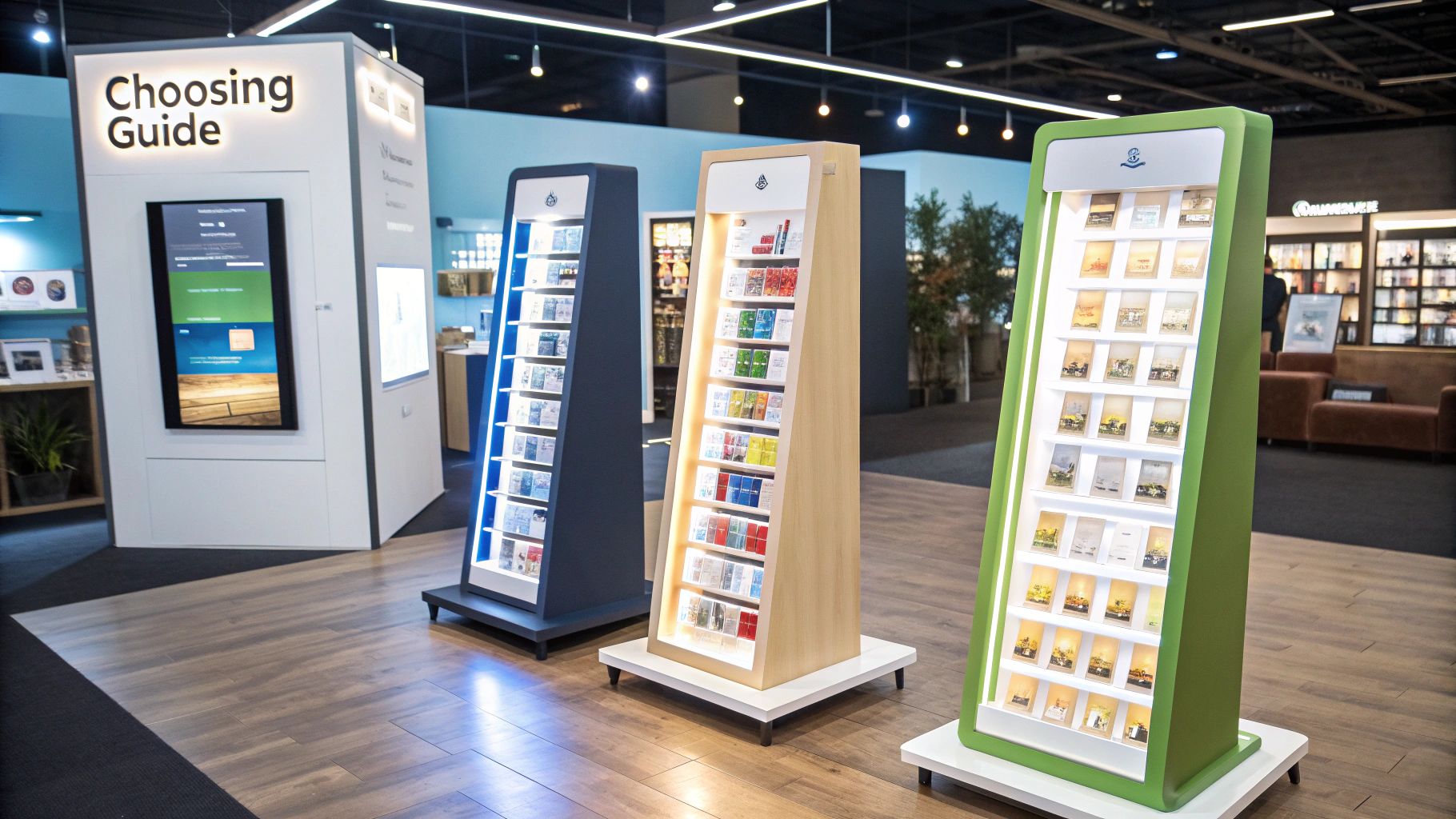
What Is a Learning Tower? Boost Toddler Independence Safely
Share
You've seen it a thousand times: your toddler, wrapped around your leg, desperately trying to see the magic happening up on the kitchen counter. A learning tower is the perfect solution. Think of it as a sturdy, enclosed safety stool that brings your child right up to counter height, letting them join in on the action safely.
The Bridge to Hands-On Learning
A learning tower is so much more than just a piece of furniture—it’s a personal viewing deck for your curious little sidekick. Unlike a wobbly chair or a basic step stool, its entire purpose is to transform your child from a spectator into an active part of daily family life.
This simple but brilliant structure gives toddlers a safe zone to explore, learn, and connect. With guardrails on all sides, the risk of a tumble is pretty much gone, which means you get peace of mind while your child gets a healthy dose of independence.
From Observer to Participant
The design is intentionally straightforward, but the impact is huge. By bringing your little one up to the level where life happens—whether that’s mixing cookie dough, washing their hands at the big sink, or helping with a craft project—the tower empowers them to get their hands dirty. And that hands-on involvement is a game-changer for their development.
The idea actually goes way back to early 20th-century educational philosophies that championed a child's independence and active role in their own environment. The modern towers we see today really took off in the 1960s and 1970s, adding crucial safety features like wide, anti-tip bases and fully enclosed sides to fix the problems with regular stools. If you're curious, you can explore more about the history of educational toys to see how these ideas have grown over time.
A learning tower’s best trick is turning routine tasks into fun, enriching experiences. It builds confidence, sharpens fine motor skills, and creates those priceless little moments of connection between you and your child.
To get a clearer picture, let's quickly break down the core features of a learning tower and what they're designed to do.
Learning Tower at a Glance
This table sums up the main purpose behind each key feature.
| Feature | Purpose |
|---|---|
| Enclosed Platform | Provides a secure, four-sided barrier to prevent falls from counter height. |
| Counter-Height Design | Elevates a child to the right level for participating in kitchen or bathroom activities. |
| Stable, Wide Base | Ensures the tower won't tip over, even with an enthusiastic and wiggly toddler on board. |
| Step for Climbing | Empowers children to get in and out on their own, fostering independence. |
Ultimately, a learning tower really shines in three key areas:
- Safety: It gives them a secure, enclosed platform to stand on, so you can stop worrying about falls.
- Independence: It lets them climb in and out by themselves and actually do things instead of just being held.
- Connection: It creates natural opportunities for you to work together, turning chores into genuine quality time.
How a Learning Tower Boosts Your Child's Development

A learning tower is so much more than just a piece of furniture for the kitchen. Think of it as a launchpad for your child's growth. By safely bringing them up to your level at the counter, it opens up a whole world of developmental benefits that touch everything from their thinking skills to their emotional confidence.
Instead of watching your life from down on the floor, your child suddenly becomes part of the action. This simple change in height turns them into an active participant, and those hands-on experiences are the bedrock of learning.
Nurturing a Curious Mind
When a toddler is right there beside you, ordinary tasks transform into amazing learning opportunities. Helping you scoop flour or count out strawberries becomes a real, tangible math lesson they'll actually remember. These little moments together are pure gold for their cognitive development.
- Problem-Solving: Figuring out how to stir without making a mess or deciding where the next piece of fruit goes on the plate builds their critical thinking.
- Sequencing: When they help you make a smoothie or wash vegetables, they're learning about order and process—first this, then that.
- Sensory Exploration: Getting to touch, smell, and see all the different ingredients is a huge sensory boost, building new connections in their brain.
If you’re a family that follows Montessori principles, a learning tower fits right in. You can learn more about creating these kinds of child-led spaces with a Montessori activity table, which is a perfect partner to a tower for expanding their creative zone.
A learning tower turns everyday chores into engaging lessons. It feeds a child's natural curiosity by letting them learn through doing, not just watching.
Building Physical and Emotional Strength
Beyond the brainy benefits, a learning tower is also a fantastic tool for physical and emotional growth. Every single time your child climbs in and out, they’re practicing and perfecting their gross motor skills. They're improving their balance and coordination in a totally safe and controlled way.
This newfound independence does wonders for them emotionally. Being trusted with a task—no matter how small it seems to us—fills a child with a powerful sense of purpose and capability. Working right alongside you also reinforces their feeling of being a valued part of the family team.
Expanding Language and Vocabulary
Finally, that side-by-side time a learning tower creates is an absolute goldmine for language. As you work on a task together, you'll naturally find yourself talking about what you're doing, introducing new words and ideas along the way.
You can ask questions, describe the textures and smells, and listen to what they have to say. This constant back-and-forth, all centered on a shared activity, is one of the best ways to grow a young child's vocabulary. It turns a simple job into a real conversation, building both their word bank and your bond.
The Anatomy of a Safe Learning Tower

When you're choosing furniture for your little one, safety is always priority number one. A well-designed learning tower is an incredibly secure tool, but it helps to know what to look for so you can make a confident choice. Let's break down the essential components that separate a truly safe tower from just a wobbly stool.
Think of a learning tower's stability as the foundation of a house—if it’s not solid, nothing else really matters. The single most critical feature is a wide, anti-tip base. This design gives the tower a solid footprint, keeping it firmly planted on the ground even when your curious toddler is wiggling, reaching, or leaning to see what you're doing.
It’s this wide base that counteracts the top-heavy physics of any tall object, providing the stability needed to prevent scary tipping accidents. Honestly, it’s the first thing you should look for.
Non-Negotiable Design Elements
Beyond the base, a few other design elements are absolutely essential for keeping your little helper secure. These features work together to create a safe, contained space for them to participate.
- Four-Sided Railings: This is what truly makes a learning tower a tower. The wrap-around enclosure acts as a protective cocoon, preventing accidental tumbles from counter height. A simple step stool just can't offer this kind of security.
- Solid, Enclosed Sides: Many of the best models have solid or slatted sides instead of open, ladder-like rungs. This is a subtle but important detail—it discourages adventurous toddlers from trying to climb out the sides and onto the counter.
- Adjustable Standing Platform: Kids grow like weeds, and an adjustable platform is crucial for long-term safety. As your child gets taller, you can lower the platform to make sure the safety rails always sit at a secure height, usually around their mid-torso.
A safe learning tower is really an integrated system. The wide base gives it stability, the railings prevent falls, and the adjustable platform ensures the tower remains a perfect, safe fit for years as your child grows.
Materials and Construction Quality
The materials a tower is made from directly affect its durability and, by extension, its safety. You want something that can withstand daily use without getting rickety over time.
Solid wood, like birch or beech, is a go-to choice for its strength and longevity. These materials give you a sturdy frame that won't wobble or buckle under your child's weight. Just as important are the finishes. Look for models with non-toxic, child-safe paints and sealants to ensure no harmful chemicals are coming into your home.
Finally, run your hands over the surfaces. A well-crafted tower will have rounded edges and smooth finishes, with no sharp corners or splintered wood to worry about. This protects little hands from scrapes and cuts while they're "helping."
For an even deeper dive into picking the perfect model, you can explore our complete guide to choosing a toddler tower for your kitchen, which covers all these features in more detail.
Finding the Perfect Learning Tower for Your Home
Knowing what makes a learning tower safe is the first big hurdle, but finding the right one for your actual, real-life home is where the fun begins. There are so many options out there now—foldable towers, convertible activity centers, you name it. The trick isn't finding the "best" one, but the best one for your lifestyle, space, and budget.
Take a look at your kitchen. Is it a big, open-plan heart of the home, or more of a cozy, galley-style space? For smaller kitchens, a foldable learning tower can be an absolute lifesaver. These are designed to be tucked into a pantry or closet when you're done, giving you that precious floor space back. You might trade a little of the rock-solid feel of a fixed model, but the convenience is often worth it.
Then again, if you have the room and you know this tower is going to get a lot of daily use (and trust me, it will), a non-folding tower with a smaller footprint might be the smarter pick. Many parents tell me they never bother folding theirs away anyway because their toddler lives in it!
Material and Budget Considerations
Alright, let's get down to the nuts and bolts: materials and cost. Most learning towers are either wood or plastic. Wooden towers, usually made from sturdy birch or beech, are loved for their durability, stability, and classic look. They’re heavier, which is great for sturdiness, and the best ones are made from solid wood with non-toxic finishes.
Plastic towers are your lightweight, often more budget-friendly, alternative. They are an absolute breeze to wipe clean—a huge plus—and can be a great way to test the waters without a huge investment. Just know they may not have the same longevity or high weight limits as their wooden cousins.
This image gives a quick visual on how wood and plastic towers generally stack up on durability versus cost.

As you can see, wood generally brings higher durability but at a higher price. Plastic is easier on the wallet but might not last through multiple kids.
Exploring Convertible and Specialty Designs
Now for the really clever stuff. A new wave of learning towers offers way more than just a lift. These designs are built to grow with your child in more ways than one, transforming to meet different needs as they get older.
A convertible learning tower is a fantastic investment in multi-purpose furniture. It transforms a single-use item into a long-lasting piece that serves different needs as your child develops.
To help you see what's out there, here's a quick comparison of the most common styles.
Learning Tower Style Comparison
| Tower Type | Best For | Pros | Cons |
|---|---|---|---|
| Standard (Non-Folding) | Constant daily use; larger kitchens | Extremely sturdy and stable; always ready for action. | Takes up permanent floor space; can be heavy. |
| Foldable | Small kitchens; occasional use | Space-saving; easy to store when not needed. | Can be slightly less stable than non-folding models. |
| Convertible (Table/Desk) | Maximizing furniture use; families with limited space | 2-in-1 functionality; great for crafts and snacks. | Conversion mechanism can be cumbersome on some models. |
| Activity Center | Keeping toddlers engaged; creative play | Includes features like easels, chalkboards, or slides. | Can be bulkier; more expensive. |
| Double-Wide | Twins or siblings close in age | Allows two children to participate at once; saves space over two towers. | Very large footprint; heavy and hard to move. |
As you can see, there's a tower for just about every family. Convertible models are especially popular, and for good reason. Here are a few of the top multi-use designs:
- Convertible Table/Desk: With a simple latch, these towers fold down to create the perfect toddler-sized table and seat. It’s a game-changer for art projects, snack time, or just a little independent play.
- Easel or Activity Center: Some towers come with attachments like a chalkboard, whiteboard, or even a slide. It turns a kitchen helper into a hub for creativity and fun.
- Double Towers: Have twins or two little ones close in age? A double-wide tower lets two kids work side-by-side at the counter without squabbles. It actually saves space compared to trying to cram two separate towers in.
If you think through your family's needs—from your kitchen layout to your budget and whether you want extra features—you can confidently pick a learning tower that will become a well-loved part of your home for years to come.
Creative Ways to Use Your Learning Tower Every Day

When most people think of a learning tower, they picture it tucked neatly against a kitchen counter. And while that’s definitely its natural habitat, its real magic happens when you start seeing it as a ticket for your toddler to join in on life all over the house.
This one simple piece of furniture can unlock countless little moments of connection and independence. Once you move past just the obvious tasks, a whole new world opens up for your little one.
Of course, the kitchen is still the main stage. But think beyond just big baking projects. Let your child help wash vegetables for dinner, tear up lettuce for a salad, or even just arrange fruit slices on a plate. These are the simple, low-mess jobs that make them feel like a real, contributing part of the family’s daily rhythm.
Beyond the Kitchen Counter
Once you start looking, you’ll find chances for tower-assisted independence everywhere. The bathroom is a fantastic place to start, turning a daily chore into a moment of pride.
- Hand Washing Station: Pop the tower in front of the sink, and suddenly your child can wash their hands all by themselves after playing or before a meal. It's a game-changer for building great self-care habits.
- Tooth Brushing Perch: It gives them the perfect boost to reach the faucet and see themselves in the mirror, making the morning and evening routine a fun, independent activity instead of a struggle.
These small acts of self-sufficiency are huge confidence boosters for a toddler. By giving them the right tool, you’re sending a powerful message: "I trust you." That helps them see themselves as capable and helpful members of the family.
The best uses for a learning tower are often the simplest ones. It’s about reframing everyday moments as an opportunity for your child to proudly say, "I can do it myself!"
A Launchpad for Play and Discovery
But the tower isn't just for chores; it's an amazing tool for supervised play and discovery. Its steady, safe platform can be moved around to open up new activities and satisfy your child’s endless curiosity.
Pull it up to a window, and it becomes a bird-watching station or a cozy spot to watch the rain fall. It’s a safe way for them to see the world from a whole new angle. You could even use it as a stand for a small easel during craft time, giving them a special spot to create their next masterpiece.
Even household tasks become a chance for teamwork. Let them "help" you sort laundry by tossing socks into a basket or watch you water the houseplants from their perch. When you're trying to figure out what is a learning tower, it helps to see it not just as a stool, but as a key that unlocks your child’s access to the real world you live in every single day.
Getting Started with Your Learning Tower
Bringing a learning tower home is such a fun milestone, but a little bit of prep work will make the transition totally seamless. Before your kiddo even thinks about climbing in, the single most important thing you can do is assemble it correctly.
Seriously, follow the manufacturer's instructions to a T. Once it's built, give it a good ol' shake test and go back over every single screw and connection to make sure they're tight. A rock-solid build is the foundation for a safe experience, giving you peace of mind and creating a sturdy platform for all the kitchen adventures to come.
Setting the Stage for Safety
Okay, the tower is built. Now, where do you put it? This is more important than you might think. A little strategic placement is your best friend for preventing accidents and creating a safe little bubble for your child to explore.
You’ll want to keep the tower a safe distance from any potential hazards. This means finding a spot away from:
- The stove, oven, or other hot surfaces
- Knife blocks or drawers with sharp utensils
- Appliance cords that a little one might be tempted to pull
- The very edge of the counter where things could easily be knocked off
Think of it as creating a designated "safe zone" for the tower. Placing it carefully lets your child focus on the fun of helping you out, and you don't have to constantly worry about what’s just within their reach.
Establishing clear, simple rules right from the very first use helps your child understand how to use their new tower safely. Consistency is everything when it comes to making these habits stick.
Establishing a Few Ground Rules
Finally, it's time for the big reveal! Introduce the tower as an exciting new tool that comes with a few simple, positive rules. It’s a great idea to have this chat with your child, giving them a sense of ownership and responsibility from day one.
Instead of a list of "don'ts" like "Don't stand on the edge," try framing it positively. Something like, "We always keep our feet flat on the platform," works wonders. If you frame the rules around staying safe so you can have fun together, it sets a much better tone. This simple approach helps make the learning tower a happy and well-loved part of your family routine for years.
Your Learning Tower Questions, Answered
Even after seeing all the ways a learning tower can enrich your child's day, it's totally normal to have a few lingering questions. Let's walk through some of the most common things parents ask so you can feel 100% confident about bringing one into your home.
What’s the Right Age to Start?
Most little ones are ready to climb aboard once they can stand confidently on their own two feet, which usually happens around the 18-month mark. But the real green light isn't a date on the calendar—it's your child's physical stability.
Always double-check the manufacturer's specific age and weight recommendations for the tower you're considering.
Is It Really Safer Than a Kitchen Chair or Stool?
Absolutely, and the difference is huge. A standard step stool or chair is open on three sides, which is a major fall risk for a wobbly toddler who’s more focused on the fun at the counter than on their footing.
A learning tower’s four-sided railings create a secure little space. This safety net lets your child focus on the activity at hand, and it lets you breathe a little easier, knowing they can’t just take an accidental step off the side.
While a tower is the perfect starting point, as your child grows, they'll eventually be ready to graduate. When that time comes, you can explore our guide to choosing the best step stool for kids.
How Do I Clean a Learning Tower?
Keeping your tower clean is refreshingly simple. For most daily splatters and spills on a wooden tower, all you need is a damp cloth and maybe a little mild soap.
It's best to skip the harsh chemical cleaners, as they can wear down the wood's protective finish over time.
It's also a great habit to periodically check that all the screws are nice and tight. With all the wiggling and climbing, things can sometimes loosen up. A quick check now and then keeps the tower sturdy and safe for every new adventure.
At Ocodile, we pour our hearts into designing beautiful, safe, and practical furniture that helps families connect during those priceless everyday moments. Explore our collection of learning towers to find the perfect addition to your home. Learn more at https://ocodile.com.








